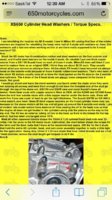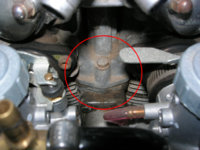Hi All:
I just skipped through this thread and it really
IS a goldmine of great info. The one contribution I might make is to reinforce the importance of
backing each fastener off BEFORE applying your torque wrench.
One of the reasons the XS650 engine is such a robust unit and that it is relatively oil-tight, is that the fastening scheme is well designed and was mainly well-executed at the factory back when the bike was built. However, that was 35 to almost 50 years ago and so it is time to do it again, and do it properly.
In particular, it is essential to ensure that the head of the fastener and the threads are not stuck - because that would give a false torque reading on your wrench.
Remember that the purpose of these fasteners is to squeeze the head
down onto the cylinder barrel and the
barrel down onto the engine case. Fastener tightening torque is a highly
IN-direct means of measuring that squeezing force. However, it is all we've got - and so it is important that the torque we apply actually goes into turning the fastener rather than over-coming resistance due to friction and/or crap seizing the fastener threads and head.
I know I have posted it before in another thread, but because this old thread and topic have come up again and the material is germane, I am attaching a slide deck that I prepared for a dinner meeting of our local chapter of the
Can. Vintage MC Group (
www.cvmg.ca). If you look at slides 17 and 19 - you will see the importance of lubricating the threads and under-head area of fasteners to ensuring true torque readings.
Other than that, I would read the thread carefully, be methodical and follow the advice of the Gurus on maximum torque and the tightening pattern (and don't forget that little hidden fastener that is snuggled down between the carburetors -
7 ft-lb ONLY on that one because it is just a little 6mm diameter machine screw).
Pete
PS - if you do not have a good torque wrench - don't even think of trying this little job on your bike.



 bummer! Next day, with gggGary's retorque result in mind, went for another short ride, enough to get the oil on temp. Let the bike warm up slowly. Result: No leaks...whut? No leaks?...So far so good! Waiting for some nice weather to see if it holds on longer trips.
bummer! Next day, with gggGary's retorque result in mind, went for another short ride, enough to get the oil on temp. Let the bike warm up slowly. Result: No leaks...whut? No leaks?...So far so good! Waiting for some nice weather to see if it holds on longer trips. 